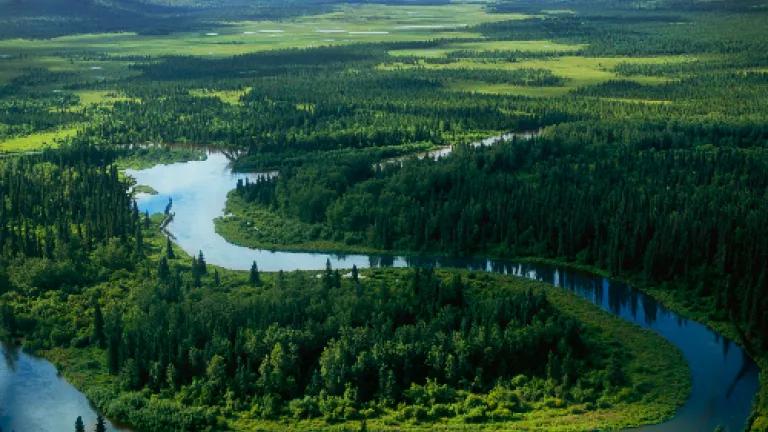
This post was originally published on LiveScience.
As a fish biologist who has worked for years to protect and restore California's beleaguered salmon fisheries, I have always been awed by — and a bit envious of — Alaska's Bristol Bay watershed. It is truly one of the last places on earth where pristine aquatic habitats, robust salmon populations and thriving commercial and recreational fisheries still exist.
But the future of this unique region is at a critical crossroads from a proposal to develop a huge, open-pit, gold and copper mine in the watershed's headwaters. True, a mine like the Pebble Mine planned by Northern Dynasty Minerals would create some jobs, incrementally add to the global metal supply and yield profits for the Canada-based company. But it will also have damaging impacts on land, water, fish and wildlife, and people in southwestern Alaska and beyond. It's a big decision, so the more information we have to inform our deliberations, the better.
The proposed Pebble Mine, one of the world’s largest gold and copper mines, would be built at the headwaters of Bristol Bay in Alaska, threatening this pristine ecosystem and the multi-billion dollar salmon fishery it supports.
Credit: Robert Glenn Ketchum.
Fortunately, last week the U.S. Environmental Protection Agency (EPA) provided the information Americans need to help us make a wise choice, releasing the final Watershed Assessment of the potential mining impacts on aquatic ecosystems and salmon fisheries of Bristol Bay.
EPA asked two questions: What is the condition of the watershed and its fisheries resources now? And, what will happen to them if a large-scale mine like the Pebble Mine is developed?
Their assessment was an exceptionally careful and rigorous process, exceeding academic and industry standards: more than three years of analysis by mining engineers, salmon biologists, aquatic ecologists, aquatic toxicologists, hydrologists, wildlife ecologists and experts on native Alaskan culture; two rounds of independent review by a panel of 12 scientists; public meetings and consideration of more than 1.1 million public comments; and complete transparency of their responses to comments from the independent peer-review panel, mine-proponents Northern Dynasty Minerals and the public. Their findings are comprehensive and couldn't be clearer.
The Watershed Assessment makes four key points.
• First, the aquatic ecosystems and fisheries of the Bristol Bay watershed are an irreplaceable resource of global significance. The wild salmon fishery — the region's mainstay industry — produces nearly half of the world's wild sockeye salmon catch, supports 14,000 local jobs, attracts tens of thousands of tourists each summer and generates hundreds of millions of dollars each year ($480 million in direct economic expenditures in 2009, and according to another study, $1.5 billion in 2010). Salmon also sustain the culture and traditions of Alaska Natives, who have relied on subsistence fishing for thousands of years.
• Second, development and operation of an open pit mine in the watershed's headwaters will destroy or degrade many miles of streams and thousands of acres of wetlands, pollute pristine waters, create massive amounts of toxic waste, and put the salmon fishery and Alaskans who depend on it at "significant risk." Because of the mine's proposed location in the watershed's headwaters and the high degree of interconnections between surface and groundwater in the region, these impacts will extend downstream and far beyond the footprint of the mine itself. Worse, a failure of the dams holding the toxic mine tailings would be "catastrophically damaging" to the ecosystem and fisheries.
• Third, this damage from a large-scale mine is unavoidable and permanent. It can't be eliminated even with the best mine design and perfect operations, it can't be remediated by restoring habitat after the mine's lifecycle ends, and it can't be mitigated by creating compensatory salmon habitat elsewhere.
• And finally, the toxic waste generated by mining operations, and the massive dams built to confine it, will have to be monitored, managed and maintained to prevent leaks and catastrophic spills — forever.
As a scientist committed to the application of science to guide sustainable environmental management, I am deeply appreciative of the careful and comprehensive evaluation of the potential effects of a large-scale mine in this sensitive area, and I am persuaded by EPA's evidence, analyses and conclusions.
Do we now have enough information to make an informed decision about whether or not to allow a mine in the Bristol Bay watershed?
I think we do. So, as a citizen with a stake in the process, I think the enduring value of the land, water, and the fishery — and the people, jobs and culture it sustains — are greater than what can be created by another mine. I choose to protect the Bristol Bay watershed and I ask EPA — which can use its authority under the Clean Water Act to prevent destruction of water, fisheries and recreational resources — to act to preserve this national treasure.
